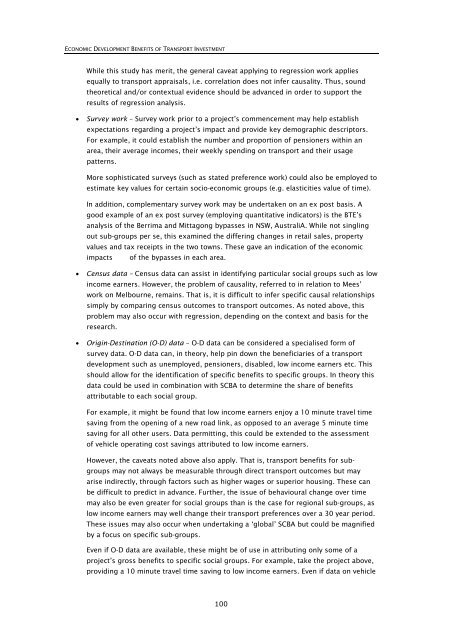Research 350 - NZ Transport Agency
Research 350 - NZ Transport Agency
Research 350 - NZ Transport Agency
You also want an ePaper? Increase the reach of your titles
YUMPU automatically turns print PDFs into web optimized ePapers that Google loves.
ECONOMIC DEVELOPMENT BENEFITS OF TRANSPORT INVESTMENT<br />
While this study has merit, the general caveat applying to regression work applies<br />
equally to transport appraisals, i.e. correlation does not infer causality. Thus, sound<br />
theoretical and/or contextual evidence should be advanced in order to support the<br />
results of regression analysis.<br />
• Survey work – Survey work prior to a project’s commencement may help establish<br />
expectations regarding a project’s impact and provide key demographic descriptors.<br />
For example, it could establish the number and proportion of pensioners within an<br />
area, their average incomes, their weekly spending on transport and their usage<br />
patterns.<br />
More sophisticated surveys (such as stated preference work) could also be employed to<br />
estimate key values for certain socio-economic groups (e.g. elasticities value of time).<br />
In addition, complementary survey work may be undertaken on an ex post basis. A<br />
good example of an ex post survey (employing quantitative indicators) is the BTE’s<br />
analysis of the Berrima and Mittagong bypasses in NSW, AustraliA. While not singling<br />
out sub-groups per se, this examined the differing changes in retail sales, property<br />
values and tax receipts in the two towns. These gave an indication of the economic<br />
impacts of the bypasses in each area.<br />
• Census data – Census data can assist in identifying particular social groups such as low<br />
income earners. However, the problem of causality, referred to in relation to Mees’<br />
work on Melbourne, remains. That is, it is difficult to infer specific causal relationships<br />
simply by comparing census outcomes to transport outcomes. As noted above, this<br />
problem may also occur with regression, depending on the context and basis for the<br />
research.<br />
• Origin-Destination (O-D) data – O-D data can be considered a specialised form of<br />
survey data. O-D data can, in theory, help pin down the beneficiaries of a transport<br />
development such as unemployed, pensioners, disabled, low income earners etc. This<br />
should allow for the identification of specific benefits to specific groups. In theory this<br />
data could be used in combination with SCBA to determine the share of benefits<br />
attributable to each social group.<br />
For example, it might be found that low income earners enjoy a 10 minute travel time<br />
saving from the opening of a new road link, as opposed to an average 5 minute time<br />
saving for all other users. Data permitting, this could be extended to the assessment<br />
of vehicle operating cost savings attributed to low income earners.<br />
However, the caveats noted above also apply. That is, transport benefits for subgroups<br />
may not always be measurable through direct transport outcomes but may<br />
arise indirectly, through factors such as higher wages or superior housing. These can<br />
be difficult to predict in advance. Further, the issue of behavioural change over time<br />
may also be even greater for social groups than is the case for regional sub-groups, as<br />
low income earners may well change their transport preferences over a 30 year period.<br />
These issues may also occur when undertaking a ‘global’ SCBA but could be magnified<br />
by a focus on specific sub-groups.<br />
Even if O-D data are available, these might be of use in attributing only some of a<br />
project’s gross benefits to specific social groups. For example, take the project above,<br />
providing a 10 minute travel time saving to low income earners. Even if data on vehicle<br />
100
















